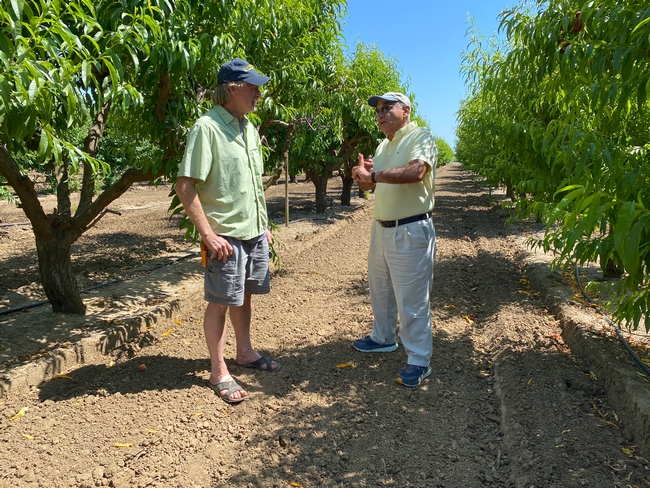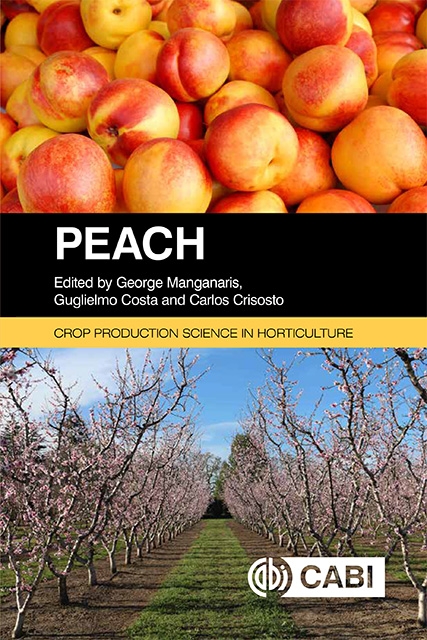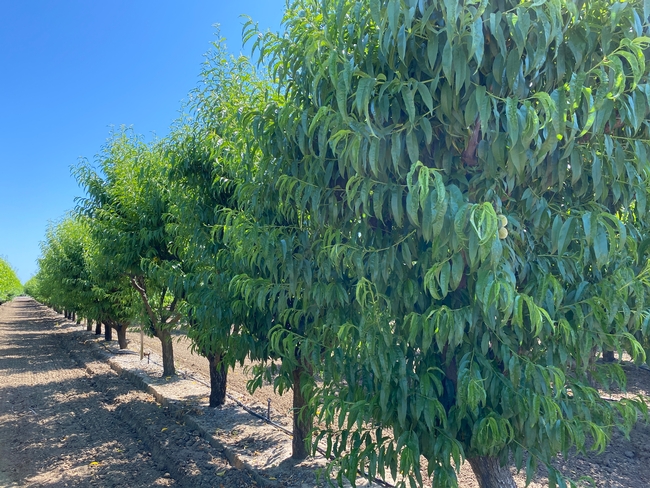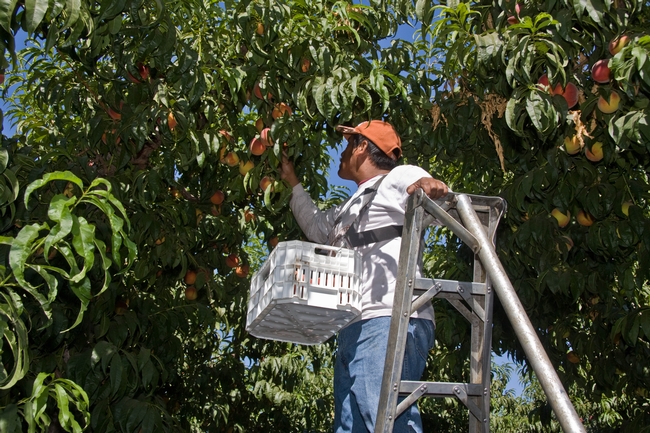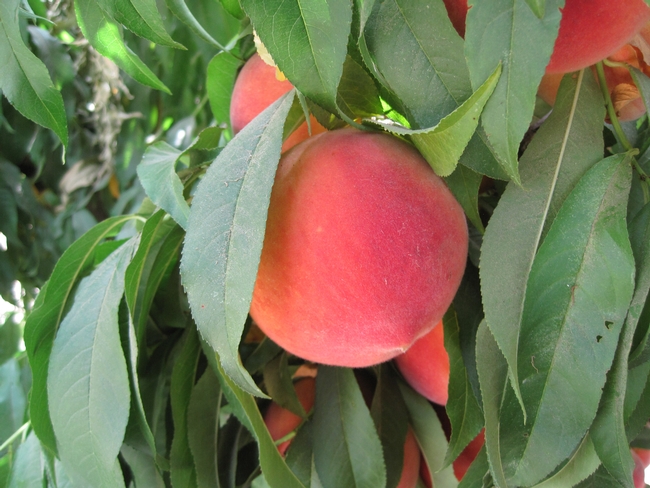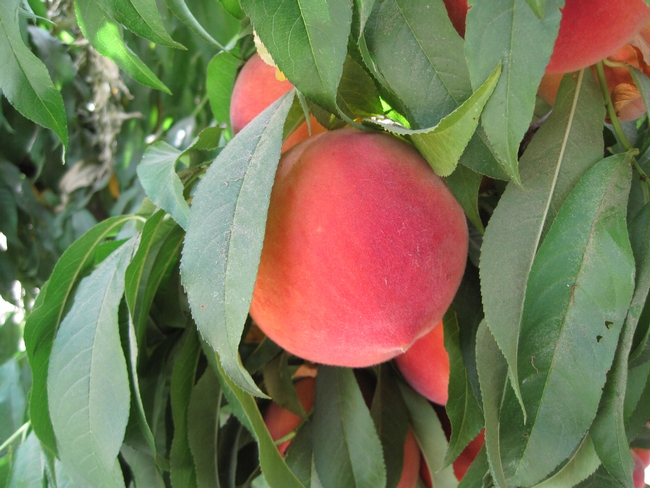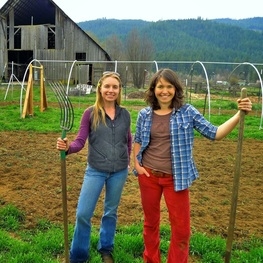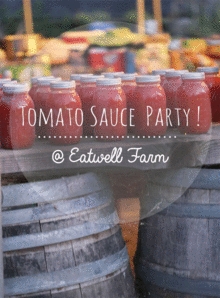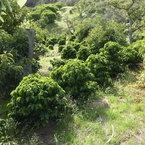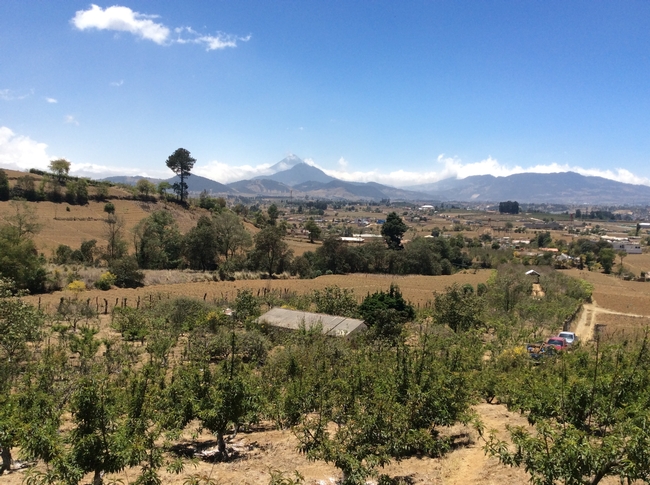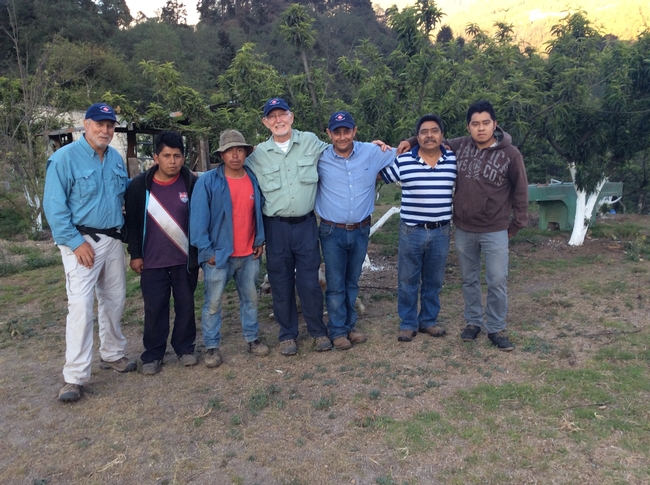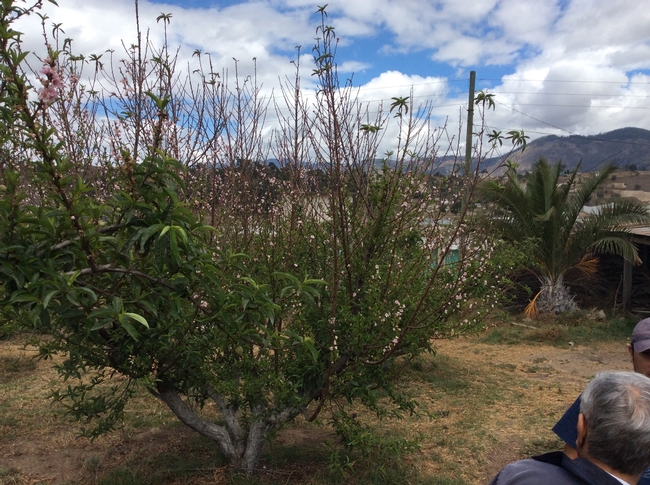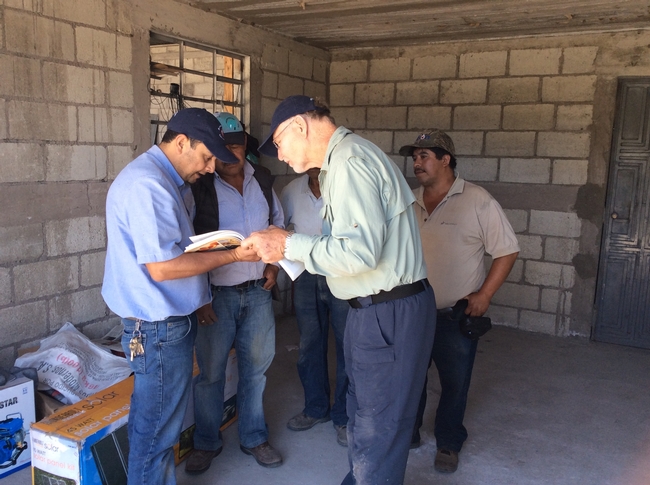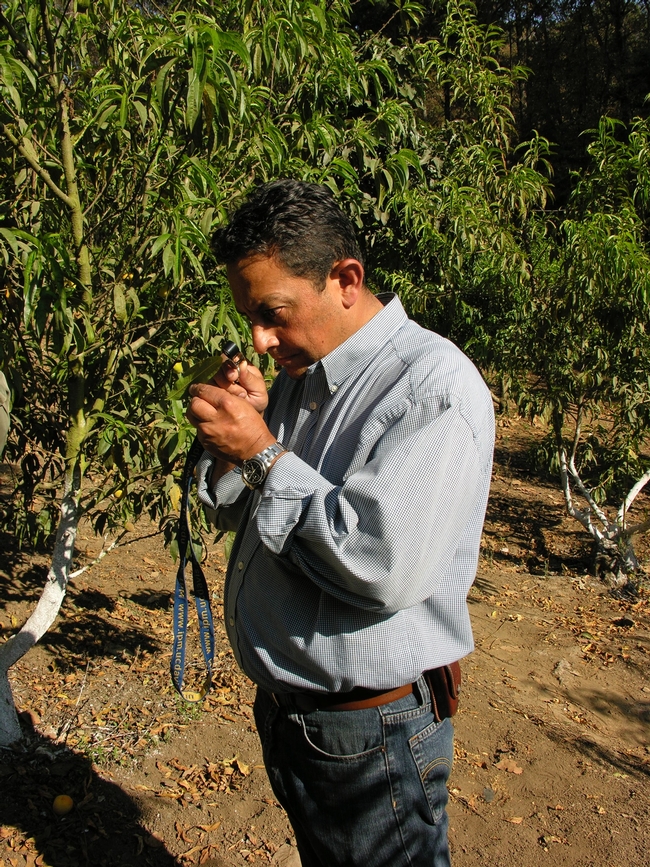Posts Tagged: Peaches
Peach book guides growing quality fruit from planting to beyond harvest
Crisosto and team publish handbook for growing peaches and maintaining quality for canning
In an experimental orchard a few miles west of the UC Davis campus, Thomas Gradziel plucked a nearly ripe nectarine from one of the trees. He whipped out a pocketknife and sliced off juicy chunks for Carlos Crisosto to taste. Both are orchard crops experts in the UC Davis Department of Plant Sciences, and both love peaches.
The two made appreciative sounds as they pulled the fruit's flavor across their palates, discussed how this nectarine variety compared to other varieties, and quickly turned to details of production and orchard management.
Crisosto and Gradziel have poured decades of experience with orchard fruits into creating “Peach,” a landmark handbook on cultivation and postharvest considerations published by CABI. The book is part of the international academic publisher's Crop Production Science in Horticulture series.
Peach gives growers basic information that can reduce their production risks, boost profits and help them face issues such as climate change and a shifting world market, CABI writes in the book's description.
“This will still be the definitive text for probably the next 20 years,” said Carlos Crisosto, who is one of the book's editors and authors. He is both a distinguished professor in the UC Davis Department of Plant Sciences and UC Cooperative Extension specialist in consumer quality and postharvest technology in UC Agriculture and Natural Resources.
Chapters also cover rootstock, cultivars, water management, fertilization, fruit growth and thinning, testing for maturity, and supply chain management after harvest. Several more chapters cover pests and diseases, maintaining fruit quality, nutritional aspects and canning.
“This book was a pleasure to contribute to, as it includes information from expert colleagues plus exciting new ideas and applications from our recent researchers,” said Gradziel, a UC Davis professor and plant breeder.
In California, farmers cultivated 36,800 acres of peaches, producing 505,000 tons of fruit worth more than $378 million in 2021. While the crop ranks 23rd in the state, based on cash receipts, California is the No. 1 producer of peaches for the entire United States, according to the California Department of Food and Agriculture.
Crisosto teamed up with colleagues George Manganaris in Cyprus and Guglielmo Costa in Italy to edit this volume, which takes an international look at a growing industry.
Fun fact mentioned in Peach: Nectarines are a peach without the fuzz, a genetic variation. “Most people don't know that!” Crisosto said with a laugh.
Peach contains more fun facts: Peaches are a member of the rose family, China is the world's largest producer of the fruit (growing 60% of the global crop), and industry leaders yearn for trees with a flat canopy so the fruit would ripen all at about the same time and could be harvested easily by machine, reducing the pressure of finding people to pick the fruit by hand.
Peach is available as an e-book and in paperback. Both cost $80 each.
To preview and order the e-book chapters, visit bit.ly/PeachBook. Get a 20% discount with the code CCAB20 during online checkout. The 424-page paperback can be ordered at https://bit.ly/PeachPaperback.
The publisher's sales staff for North America and South America are based in Herndon, Virginia, and can be reached at StylusMail@PressWarehouse.com, (703) 661-1581 or (800) 232-0223.
This Peach book complements our previous publication, “Manual on postharvest handling of Mediterranean tree fruits and nuts,” Crisosto said. “These two publications contain state-of-the-art production and postharvest information that support our research and information centers, UC ANR mission and our academic teaching.”
Late-harvest processing peaches produce more profit, new UC studies show
Tree fruit growers can receive premiums for delivering certain extra-early varieties of peaches, but peach farmers may net roughly $800 more per acre from late-harvest processing peaches than extra-early harvest varieties, according to new cost studies released by the UC ANR Agricultural Issues Center and UC Cooperative Extension.
To help farmers make decisions on which peach varieties to plant, UC researchers present sample costs to produce extra-early harvested cling and freestone peaches and late harvested cling and freestone peaches for processing in the Sacramento and San Joaquin Valley in these studies.
Although processors pay more for extra-early harvested peach varieties than late-harvest peaches, the researchers found that yields are higher for late-harvest varieties while costs for hand thinning the fruit are lower.
“Peaches harvested early in the season have less time to grow compared to peaches that get to hang on the tree another month or more,” explained Roger Duncan, UC Cooperative Extension advisor in Stanislaus County, who coauthored the studies. “Therefore, more fruit has to be removed so the remaining fruit can size. That means it costs you more to produce less.”
The analyses are based upon hypothetical well-managed farming operations using practices common to the region. The costs, materials and practices shown in these studies will not apply to all farms. Growers, UC ANR Cooperative Extension farm advisors and other agricultural associates provided input and reviewed the methods and findings of the study.
Both studies assume a 100-acre farmer-owned operation with 40 acres of cling peaches. The remaining acreage for both hypothetical farms is planted in other mature tree crops. The estimated economic life of the extra-early harvested cling peach orchard and the late harvested cling peach orchard is 18 years.
Some of the major differences between the two studies are return price, yield and fruit thinning cost. The extra-early harvested varieties have a price of $545 per ton, a yield of 17 tons per acre, and a thinning cost of $1,445 per acre. The late harvested varieties have a price of $490 per ton, a yield of 20 tons per acre, and a thinning cost of $1,177 per acre.
Asked if a small farm could save on fruit thinning expenses by doing it themselves, Duncan replied, “I guess it would be possible for a small family operation to do the thinning themselves, but not likely. It can take 20 to 40 minutes to thin a single tree. If there are 151 trees per acre, you can see that it would take one skilled person over a week to thin one acre.”
The authors describe the assumptions used to identify current costs for production material inputs, cash and non-cash overhead. Ranging analysis tables show net profits over a range of prices and yields. Other tables show the monthly cash costs, the costs and returns per acre, hourly equipment costs, the whole farm annual equipment, investment and business overhead costs and the operations with equipment and materials.
Free copies of “Sample Costs to Produce Processing Peaches, Cling and Freestone Extra-early Harvested Varieties, in the Sacramento and San Joaquin Valley – 2017” and “Sample Costs to Establish and Produce Processing Peaches, Cling and Freestone Late Harvested Varieties, in the Sacramento and San Joaquin Valley – 2017” are available on the UC Davis Department of Agricultural and Resource Economics website at https://coststudies.ucdavis.edu. Sample cost-of-production studies for many other commodities are also available.
The cost study program is funded by the UC Agricultural Issues Center and UC Cooperative Extension, both part of the UC Division of Agriculture and Natural Resources, and the UC Davis Department of Agricultural and Resource Economics.
For additional information or an explanation of the calculations used in the studies, contact Jeremy Murdock at the Agricultural Issues Center, at (530) 752-4651, Janine Hasey, UC Cooperative Extension advisor for Sutter/Yuba counties, at (530) 822-7515, or Duncan at (209) 525-6800.
California peaches are in good shape
The warmest winter since 1907 in south-central Texas has left its peach crop with inadequate chill hours this year, reported Lynn Brezosky in the San Antonio Express-News.
Without sufficient chill hours over the winter, the buds didn't get the re-boot they need to bloom in proper synchrony, which is important for blossoms to set fruit. The leaves have also been slow to emerge. "The trees look like it's still winter," said Jim Kamas, Texas A&M AgriLife Extenson horticulturalist.
“The lack of chill hours is a big deal,” said Larry Stein, extension horticulturalist with AgriLife Research & Extension Center.
The Texas trouble combined with a cold blast that destroyed half the crop in Georgia and North Carolina this spring mean peaches are likely to be in short supply this year.
The sweet spot, Brezosky wrote, may be California, the No. 1 peach producer in the nation. Roger Duncan, UC Cooperative Extension pomology adviser, could think of no major problems affecting the southern part of the state's fresh market peach crop.
“I think in general it's probably going to be just fine,” he said.
Summer farm fun
This time of year, most farmers don't get much sleep. Tomatoes, pears and peaches often ripen in the Sacramento Valley faster than the harvest crews can pick them, even working 12-hour days. But this is also the season that some farmers are happy to show off their farms to visitors, inviting guests to enjoy the delightful flavors and beauty of the harvest in a pause from the bustle. UC Cooperative Extension hosts an online agritourism directory and calendar, www.calagtour.org, to help Californians find farms and ranches to visit. Here are a few upcoming opportunities for summer fun on California farms, pulled from the calendar:
- Plumas County Farm Crawl - Up the Feather River Canyon, on the eastern side of the Sierras, are the beautiful communities of Quincy and Indian Falls. Small-scale growers, members of Plumas Grown, offer tours and fresh snacks from their fields from 8 a.m. to 12 p.m. on Saturday August 6, 2016. Each farm will offer tours on the half hour (8:30, 9:30, 10;30 and 11:30). Participating farms include a school garden project, Five Foot Farm, Shoofly Farm and Sundberg Growers. Strawberries, tomatoes, garlic, carrots, huge heads of lettuce, hoop houses, and intense cultivation on small plots will be featured. Bring the kiddos, friends and family (no dogs please). All of these operations use sustainable growing practices and are happy to chat with you about why they love to grow good food. Admission by donation, no pre-registration required. Learn more: (707) 217-6415 or www.plumasgrown.com/
- Good Humus Peach Party (Yolo County) - Every year on the first Saturday in August, Jeff and Annie Main, owners of 20-acre Good Humus Produce, hold a celebration to give thanks for the year's fruit harvest. They invite you all to come out, see the farm, have a refreshment and enjoy all that Good Humus has to offer. This is a pot luck party; guests are asked to bring a dish to share and their own plates, silverware and cups. No cost, but donations are welcomed. The Mains will provide peach pies, peach ice cream, peach salsa, peach pizzas, and more. You are invited to come early and be part of the experience of making all the peachy fun food. Other activities include a treasure hunt, farm tours, stock tank dipping, music and neighborly chat. Saturday August 6, 1 p.m. - 11 p.m. Learn more
- Tomato Sauce Party at Eatwell Farm (Solano County) - It's time to join in on the tradition. Let's get canning! Tomato season is in full swing on the farm, and the plants are bursting with ripe and juicy tomatoes ready for picking. Join us as we harvest the bounty of the farm, toss it in a pot, and create delicious tomato sauce to savor the rest of the year. The produce is free, so bring as many jars as you can process over the two day event. The ticket price covers the cost of hosting the event and paying staff. Cost: adults $20, Children $5. August 6 - 7, 2016 Learn more and buy tickets here
- Grape Days of Summer (Placer County) - Celebrate PlacerGROWN — local wine, local food, local agriculture. Take a self-guided tour of up to 20 wineries, taste foothill wines and enjoy a unique and educational experience at each stop on the Placer County Wine Trail. Saturday & Sunday, August 6 & 7, 11 a.m. to 5 p.m. WHERE: Placer County Wine Trail - Auburn, Lincoln, Loomis, Meadow Vista, Newcastle & Rocklin. Activities: Learn About Wine & Wine Making • Live Music at Some Locations • Food at Every Winery • Barrel Tastings • Vineyard Tours • Vertical Tastings • . . . and more! Tickets: Weekend Pass - $45.00, Sunday Only - $25.00/person, Designated Driver - $10.00/person website, more info
- Wine and Produce Passport Weekend (Sacramento River Delta) - Just minutes from Sacramento and Elk Grove, along scenic CA Hwy 160, Delta Farm and Winery Trail members will open their farms and wineries to the public. Farms are open from 9:00 a.m. to 5:00 p.m. and wineries from 11:00 a.m. to 5:00 p.m. During Passport Weekend, enjoy farm tours, local wine tastings, farm equipment displays, and contests. Fresh produce - including tomatoes, pears, melons, squash, stone fruits, sweet corn, zucchini, beans, eggs, and organic produce - will be readily available at many of the farms. Saturday and Sunday August 13 and 14. Tickets: adults $25 in advance, $35 week of purchase and are valid for both days. Kids under 21 are free. Tickets are available for purchase online at www.deltapassport2016.eventbrite.com. Each visitor over 21 will receive a wine glass at their first winery stop. sacriverdeltagrown.org/
- Good Land Organics Coffee Tour (Santa Barbara County) - The tour will be lead by Good Land Organics owner and grower, Jay Ruskey. You will be welcomed with fresh coffee, freshly made juice and seasonal fruit. Jay will give an overview of the coffee research collaboration that has been conducted with the assistance of the University of California Small Farm Program. He will then lead you on a moderate level hike where Ruskey will explain the dynamics of new crop adaptation and integration of organic tree fruit agriculture. The walk will take you through the eclectic mix of exotic fruit varieties that grow on the farm. Each person will have an opportunity to taste a fresh picked coffee berry and discover the original flavors of the coffee bean, while discussing coffee cultivation and post harvest processing. On your return hike, there will be time for open discussion and for any further questions. At noon you have the option to enjoy your picnic lunch at our pond. August 13, 2016, 10:00 a.m. - 1:00 p.m. Cost: $50 per person. website, reservations
Learn about more farms, ranches and adventurous fun at www.calagtour.org.
IPM information extends to apple and peach growers in Guatemala
Did you know that apples and peaches are two important fruit crops planted in the highlands of Guatemala? More than 7,600 acres of apples and 6,100 acres of peaches are grown. However, with warm winters that don't allow for the winter chilling time that these crops require for optimal growth, and with freezing spring temperatures along with summer rains, growing apples and peaches in this area is often a challenge for growers.
As part of the Farmer-to-Farmer Program sponsored by the Partners of the Americas and funded by the United States Agency for International Development (USAID), retired UC IPM entomologist Walter Bentley and Washington State University entomologist Jay Brunner traveled to Guatemala in April to help growers improve the peach and apple industry. Their primary goal was to identify pest problems and possible solutions to help peach and apple growers improve fruit production, taking into account the region's unique climate.
“The most important issues were horticultural,” said Bentley. “The region's biggest need is for a horticulturist or plant pathologist.”
Some of the peach varieties require 300 to 500 chilling hours.
“Peach trees at elevations of 7,500 to 9,000 feet above sea level bloom for 2 months whereas bloom in California lasts just 10 days," he said. "You would get situations where the top half of the tree was in bloom while the bottom half was already producing fruit.”
This creates an environment favoring disease development and causing further problems for growers if the disease was severe enough to warrant a pesticide treatment. If a tree was partially in bloom while simultaneously producing fruit, it would have to be hand-sprayed multiple times so that the portion of the tree that warranted treatment was sprayed.
Although most of the important issues that Bentley and Brunner found were horticultural or disease-related, there were some insect problems. Many growers had stink bugs and other plant bugs attacking their trees. Spider mites and predatory mites were also observed. Growers sprayed pyrethroids after bloom to help prevent plant bug damage. However, applying pyrethroids reduced predatory mites, leading to an outbreak of spider mites.
After spending seven days touring four to six farms per day and looking at various practices, Bentley and Brunner spent the next week leading workshops for farmers and discussing integrated pest management (IPM) approaches to managing problems. Using the UC IPM website, specifically the Pest Management Guidelines for apples and peaches, Bentley and Brunner were able to teach sampling methods, stress the importance of correct pest identification, and encourage growers to spray with the least toxic and disruptive products. Bentley and Brunner were surprised by the large variety of pesticides available to growers, but were encouraged that farmers were willing to spray only when necessary while being open to other methods of control.
Both entomologists plan to keep the lines of communication open and feel the observations made during this trip could lead to future visits where sustainable pest management programs can be put into action. For example, predatory mites were observed in several of the orchards. This could lead to developing a biological control program to control spider mites.
Bentley and Brunner were impressed by the staff that took them around to each farm and by the growers who were receptive to new ways of managing pest problems. The farmers were very appreciative of the advice they received and were very generous. “Everywhere you went people wanted to share what they had,” said Bentley. “They are amazing people.”
Humbled by the experience, Bentley reflected, “I'm glad I went. I've been given a lot in my life and wanted to give back a little.”

